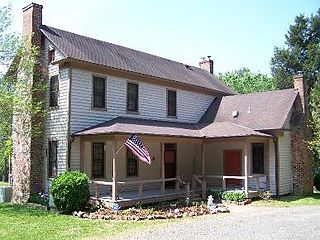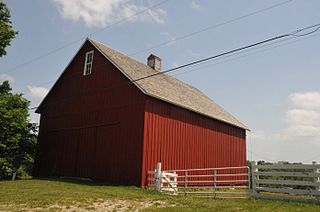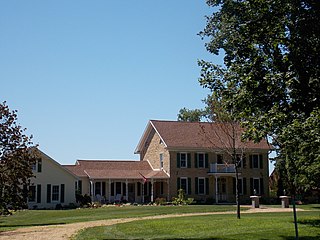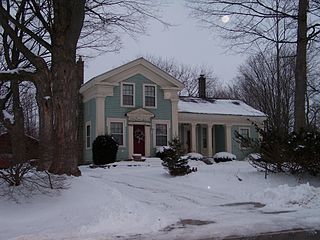
Blackacre State Nature Preserve is a 271-acre (110 ha) nature preserve and historic homestead in Louisville, Kentucky. The preserve features rolling fields, streams, forests, and a homestead dating back to the 18th century. For visitors, the preserve features several farm animals including horses, goats, and cows, hiking trails, and a visitor's center in the 1844-built Presley Tyler home. Since 1981, it has been used by the Jefferson County Public Schools as the site of a continuing environmental education program. About 10,000 students visit the outdoor classroom each year.

The Taylor–Bray Farm is a farm in Yarmouth Port, Massachusetts, and was originally owned and settled by Richard "of the Rock" Taylor in 1639 while it was still part of Plymouth colony. Stephen Hopkins (settler), a distant maternal line ancestor, was given permission to build a house and cut hay near this farm in 1638, but the first house in Yarmouth built by an Englishman was built by his son Giles in 1638.

Greenwood Farm is a historic property and nature reserve located in Ipswich, Massachusetts, which is owned by The Trustees of Reservations. It features the Paine-DodgeHouse, a First Period farmhouse constructed in 1694.

The Farm House, also known as the Knapp–Wilson House, is the oldest building on the campus of Iowa State University in Ames, Iowa. Now a museum open to the general public, this house was built 1861-65 as part of the model farm that eventually became Iowa State. It was designated a National Historic Landmark in 1964 for its association with agriculturist and teacher Seaman A. Knapp and with U.S. Secretary of Agriculture James Wilson, both of whom lived here while teaching at Iowa State.

The James Mangum House is a historic home located near Creedmoor, Wake County, North Carolina. Built in 1838, it is an example of Federal architecture. In November 1974, the James Mangum House was listed on the National Register of Historic Places.

The Harry S. Truman Farm Home, also known as the Solomon Young Farm, is a historic farm property at 12301 Blue Ridge Blvd in Grandview, Missouri. The farm property, first developed in the 1860s, was the residence of future U.S. president Harry S. Truman from 1906 to 1917. The house is part of Harry S. Truman National Historic Site, and is a designated National Historic Landmark.

The Cobblestone Farm and Museum, which includes the Dr. Benajah Ticknor House is an historical museum located at 2781 Packard Road in Ann Arbor Michigan. The museum gets its name from the cobblestone used to build the farmhouse. It was listed on the National Register of Historic Places in 1972 and designated a Michigan State Historic Site in 1973.

The Henry H. Smith/J.H. Murphy House is a historic building located on the east side of Davenport, Iowa, United States. It was listed on the National Register of Historic Places in 1983. In 1997 it was listed on the Davenport Register of Historic Properties as the Octagon House.

The Collins House is a historic building located on the eastside of Davenport, Iowa, United States. It has been listed on the National Register of Historic Places since 1976, and on the Davenport Register of Historic Properties since 1993. Built as a farmhouse in 1860 the city of Davenport purchased the property and renovated it for a senior center in the mid 1970s.

Squire Cheyney Farm is a historic farm and national historic district located in Thornbury Township, Chester County, Pennsylvania. The district encompasses two contributing buildings, three contributing sites, one contributing structure, and contributing object. They are the farmhouse, barn, ruins of a granary, remains of an ice house, a spring house (1799), stone retaining wall, and family cemetery. The house was built in four periods, with the oldest dated to about 1797. The oldest section is a 2 1/s-story, three bay, stuccoed stone structure with a gable roof. The additions were built about 1815, about 1830, and about 1850, making it a seven-bay-wide dwelling. It is "L"-shaped and has a slate gable roof. During the American Revolution, Thomas "Squire" Cheyney [II] informed General George Washington during the Battle of Brandywine that the British were flanking him to the north. He was later appointed to the Pennsylvania Ratifying Convention to ratify the United States Constitution. The site is now a township park known as Squire Cheyney Farm Park.

The Robert William Andrew Feller Farmstead is a federally designated historic site a couple miles northeast of Van Meter in Dallas County, Iowa, United States. It is the boyhood home of Major League Baseball Hall of Fame pitcher Bob Feller. The historic district is 1.2 acres (0.49 ha). The Feller family farm was once 350 acres (140 ha) but most of it has been sold to other farmers and the current farm is 40 acres (16 ha). Feller sold the farmstead in 1955 and it is currently owned by Dr. Jose Angel since about 1994.

The Peter Dierks House, also known as the Preston Creveling House, is an historic residence located in rural Clinton County, Iowa, United States. It was listed on the National Register of Historic Places in 1998.

Samuel Nichols House is an historic residence located in rural Muscatine County, Iowa, United States near the town of Nichols. It has been listed on the National Register of Historic Places since 1978.

The Peter and Mary Smith House, also known as the Hopkins House and the Otto House, is a historic dwelling located in Lake City, Iowa, United States. Peter Smith was a pioneer to this town and a prominent businessman. He was involved in retail, banking, and real estate. Smith and his first wife Sarah settled in Calhoun County, Iowa from Cass County, Michigan around 1855, and bought land near the present Smith Farmhouse. He served as the first judge in the county when Lake City was the county seat. Sarah died in 1875 while they were living in Glidden, Iowa. After the arrival of the railroad in 1881, Peter and his second wife Mary moved to Lake City. They built this two-story, brick, L-shaped house in 1887. While it does not conform to any one style, it is primarily a combination of the Italianate and the Gothic Revival styles. The Italianate influence is found in the bracketed cornice, segmentally arched lintels, wooden cutout designs over the windows, a front bay window, and the hipped roof. The influences of the Gothic Revival style are found in the bargeboard and the roof line. The house was listed on the National Register of Historic Places in 1990.

The J.G. and Regina Long House, also known as Maple Grove Hill Farm, is a historic residence located southeast of Prairie City, Iowa, United States. Joseph Grayson "Joe" Long was a native of Greene County, Pennsylvania. He and his brother Jesse relocated to Jasper County, Iowa where they each bought extensive land holdings and farmed. Joe had married Mary Bussey in Pennsylvania, but she died before he relocated to Iowa. He married Regina Hiskey, a native of Richland County, Ohio. They had two sons. Mental illness plagued the family. Jesse committed suicide on his farm and Joe was institutionalized near the end of his life. He died here in 1901, and Regina died here in 1925. Their son Charles owned the farm from 1902 to 1934. This Italianate style house was originally built just outside of the city limits of Monroe, Iowa. The person who bought the property in 2012 didn't want the house so it was sold and relocated to a site similar to its historic rural setting in 2013, southeast of Prairie City. The Iowa State Historic Preservation Office assisted with the move. The two-story frame house follows an L-shaped plan. It features a double and triple bracketed cornice, and a two-story porch in the ell of the house. The house was listed on the National Register of Historic Places in 1997.

The Evan F. Ellis Farmhouse is an historic residence located north of Bussey, Iowa, United States. Evan, his wife Bertha, and their two daughters moved from Illinois and settled on the 120-acre (49 ha) farm they bought in Marion County, Iowa in 1909. He built this Sears, Roebuck & Co. "Honor Bilt Modern Homes" pre-cut house in 1913. It was unusual for such a house to be built in a rural area because all the parts would have to be transported a longer distance. The two-story frame house features a full-length front porch, projecting wall dormers, and it is capped with a hipped roof. After Evan's (1949) and Bertha's (1959) deaths, their daughter Mary continued to live in the house and run the farm until her death in 1974. While the family continued to own the farm, the house was rented to tenants until 1983 when Bonnie Vanderlinden Noah, Evan and Bertha's granddaughter, and her husband Jack began restoring the house for them to live in. The house was listed on the National Register of Historic Places in 1985.

Catalpa, also known as Wallace Farm, is a historic farm located southeast of Greenfield, Iowa, United States. It is associated with Henry Cantwell Wallace, who owned and operated the influential agricultural publication Wallace's Farmer, and served as U.S. Secretary of Agriculture (1921-1924). It is also associated with his son Henry Agard Wallace, who followed his father at the newspaper and served as U.S. Secretary of Agriculture (1933-1940), Vice President of the United States (1941-1945) and U.S. Secretary of Commerce (1945-1946). He was the Progressive Party candidate for president in 1948. This was one of several farms owned by the Rev. Henry Wallace, Henry Cantwell's father. It was acquired by the family in 1877, and it was operated by a tenant farmer until Henry Cantwell took it over. His son Henry Agard was born here in 1888. After five years Henry Cantwell returned to his studies at Iowa State University in Ames and the family left the farm at that time. It was listed on the National Register of Historic Places in 1974. The designation includes the farmhouse and outbuildings, which are modest frame structures with gable roofs, and a 200-acre (81 ha) plot of farmland. The house and barn were built before the Wallace's moved here in 1887.

The George Louk Farm is a rural farmstead located at 1885 Tooley Road near Howell, Michigan. It was listed on the National Register of Historic Places in 1995.

The Jacob Fishbeck Farmstead is a farm located at 5151 Crooked Lake Road in Genoa Township, Michigan. It was listed on the National Register of Historic Places in 2003.
The Milo Prentice Newberry House is a single-family house located at 705 Bloomer Road in Rochester, Michigan. It was listed on the National Register of Historic Places in 2018. It is the last remaining Victorian-era farmhouse located within the limits of the City of Rochester.






















